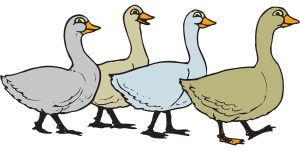
The history of the nursery rhyme Goosey Goosey Gander is all about how Henry VIII was persecuting priests in his time. This went on with Oliver Cromwell later on after the king’s death, and the priests were given places to hide.
The Hiding Holes
There were many hiding holes put into the Catholic Churches of the time because they needed to have places for the priests to hide from persecutors. This is quite important for the religious people of the time because they tried to protect their priests, and they were often present if a priest was discovered.
The Stairs
The nursery rhyme talks about going up and down the stairs. That is important because it is what would happen when the priests were found. They would often be brought out of their hiding holes, and they would be thrown back down the stairs. The rhyme clearly calls attention to that, and the gander would be the priest who was thrown back down the stairs.
Why This Rhyme?
We often say things that have social significance, and there are many people who were concerned about their priests at the time that this rhyme came about. They knew that the king was on the wrong side of history, and they were aware of how hard it was for these priests to do their jobs. The tensions between the Church of England and the Catholic Church exist to this day, and the rhyme has persisted as well. The rhyme eventually came to America, and it spread even further throughout the world.
Today
This is one of the shorter rhymes that was created for children. You may read this rhyme realizing that it is much easier to teach your children, and they will memorize it quite easily. It is simple for someone to learn this rhyme because they may have heard it before, and it is even more possible that a child could teach it to their children in the future. The simplicity of the rhyme makes it easier to spread. There are many people who know this rhyme without knowing what it means. It has mysterious origins, but today it’s a fun and innocent song that children can recite.